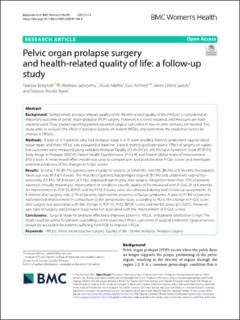| dc.contributor.author | Belayneh, Tadesse | |
| dc.contributor.author | Gebeyehu, Abebaw | |
| dc.contributor.author | Adefris, Mulat | |
| dc.contributor.author | Rørtveit, Guri | |
| dc.contributor.author | Gjerde, Janne Lillelid | |
| dc.contributor.author | Ayele, Tadesse Awoke | |
| dc.coverage.spatial | Ethiopia, Gondar | en_US |
| dc.date.accessioned | 2021-06-24T09:07:44Z | |
| dc.date.available | 2021-06-24T09:07:44Z | |
| dc.date.created | 2021-04-15T12:53:21Z | |
| dc.date.issued | 2021 | |
| dc.identifier.citation | Belayneh, T., Gebeyehu, A., Adefris, M., Rortveit, G., Gjerde, J. L., & Ayele, T. A. (2021). Pelvic organ prolapse surgery and health-related quality of life: a follow-up study. BMC Women's Health, 21(1). | en_US |
| dc.identifier.issn | 1472-6874 | |
| dc.identifier.uri | https://hdl.handle.net/11250/2761062 | |
| dc.description.abstract | Background
Symptomatic prolapse impairs quality of life. Health-related quality of life (HRQoL) is considered an important outcome of pelvic organ prolapse (POP) surgery. However, it is rarely reported, and measures are inadequately used. Thus, studies reporting patient-reported surgical outcomes in low-income contexts are needed. This study aims to evaluate the effect of prolapse surgery on patient HRQoL and determine the predictive factors for change in HRQoL.
Methods
A total of 215 patients who had prolapse stage III or IV were enrolled. Patients underwent vaginal native tissue repair, and their HRQoL was evaluated at baseline, 3 and 6 months postoperatively. Effect of surgery on subjective outcomes were measured using validated Prolapse Quality of Life (P-QoL-20), Prolapse Symptom Score (POP-SS), Body Image in Prolapse (BIPOP), Patient Health Questionnaire (PHQ-9), and Patient Global Index of Improvement (PGI-I) tools. A linear mixed-effect model was used to compare pre- and postoperative P-QoL scores and investigate potential predictors of the changes in P-QoL scores.
Results
In total, 193 (89.7%) patients were eligible for analysis at 3 months, and 185 (86.0%) at 6 months. Participant’s mean age was 49.3 ± 9.4 years. The majority of patients had prolapse stage III (81.9%) and underwent vaginal hysterectomy (55.3%). All domains of P-QoL improved significantly after surgery. Altogether more than 72% of patients reported clinically meaningful improvement in condition-specific quality of life measured with P-QoL-20 at 6 months. An improvement in POP-SS, BIPOP, and the PHQ-9 scores were also observed during both follow-up assessments. At 6 months after surgery, only 2.7% of patients reported the presence of bulge symptoms. A total of 97.8% of patients had reported improvement in comparison to the preoperative state, according to PGI-I. The change in P-QoL score after surgery was associated with the change in POP-SS, PHQ, BIPOP scores and marital status (p < 0.001). However, age, type of surgery, and prolapse stage were not associated with the improvement of P-QoL scores.
Conclusions
Surgical repair for prolapse effectively improves patient’s HRQoL, and patient satisfaction is high. The result could be useful for patient counselling on the expected HRQoL outcomes of surgical treatment. Surgical service should be accessible for patients suffering from POP to improve HRQoL. | en_US |
| dc.language.iso | eng | en_US |
| dc.publisher | BioMed Central | en_US |
| dc.rights | Navngivelse 4.0 Internasjonal | * |
| dc.rights.uri | http://creativecommons.org/licenses/by/4.0/deed.no | * |
| dc.subject | HRQoL | en_US |
| dc.subject | pelvic reconstructive surgery | en_US |
| dc.subject | quality of life | en_US |
| dc.subject | uterine prolapse | en_US |
| dc.subject | prolapse surgery | en_US |
| dc.title | Pelvic organ prolapse surgery and health-related quality of life: a follow-up study | en_US |
| dc.type | Peer reviewed | en_US |
| dc.type | Journal article | en_US |
| dc.description.version | publishedVersion | en_US |
| dc.rights.holder | © The Author(s) 2021 | en_US |
| dc.source.pagenumber | 1-11 | en_US |
| dc.source.volume | 21:4 | en_US |
| dc.source.journal | BMC Women's Health | en_US |
| dc.identifier.doi | 10.1186/s12905-020-01146-8 | |
| dc.identifier.cristin | 1904278 | |
| cristin.ispublished | true | |
| cristin.fulltext | original | |
| cristin.qualitycode | 1 | |

